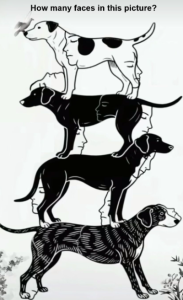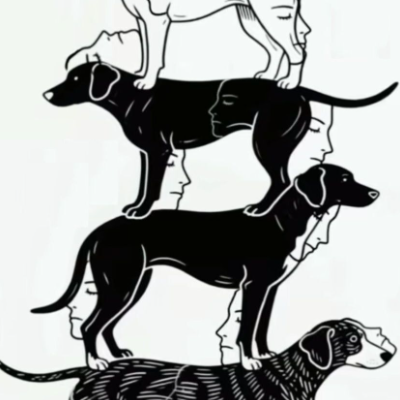 How Many Faces Are Hidden in This Picture?
How Many Faces Are Hidden in This Picture?
At first glance, this picture seems simple: four dogs standing on top of one another, forming a vertical stack, with a small bird flying near the top dog. The dogs are drawn in black-and-white outlines, with their bodies blending into one another. But hidden within the lines, the shadows, and the spaces are a surprising number of human faces. This optical illusion challenges not just your eyes but also your perception, attention to detail, and patience.
So let’s slow down, sharpen our focus, and carefully count every hidden face in the picture.
The First Look: What Most People See
When someone first encounters this puzzle, they usually see only the dogs. Their eyes are immediately drawn to the four animals because they dominate the scene. But then, the subtle details begin to emerge: outlines of human profiles cleverly drawn into the dogs’ shapes, ears, and legs. Some faces are obvious, while others are masterfully hidden.
This is what makes the question “How many faces are in this picture?” so intriguing. Everyone answers differently at first, often underestimating how many there really are. Some may find only five or six, while others—after staring for a long time—discover ten or more.
Breaking Down the Dogs
Let’s carefully examine each dog, from the top down, to identify the hidden faces.
1. The Top Dog (White with Spots)
-
Face 1: To the left of its chest, just beneath the bird, there’s a clear human profile looking left.
-
Face 2: Right in the middle of its body, another face can be seen drawn with the outline of its spots.
-
Face 3: Just under its back legs, to the right side, another faint profile emerges, cleverly disguised.
The top dog alone has three hidden faces if you observe closely.
2. The Second Dog (Black)
-
Face 4: Near the chest, clearly visible in the outline, looking to the left.
-
Face 5: In the midsection, faint but noticeable, another profile faces outward.
-
Face 6: Near the hind leg, there’s yet another face, again incorporated into the outline.
This dog contains at least three distinct faces as well.
3. The Third Dog (Black)
-
Face 7: At the very front leg, a human face is drawn into the shape.
-
Face 8: Near the stomach area, another face peers outward.
-
Face 9: Toward the rear, along the hind section, another profile is present.
Again, three faces can be spotted here with careful inspection.
4. The Bottom Dog (Striped)
-
Face 10: At the very front, beneath the head, a full human profile is clear.
-
Face 11: Near the stomach, another hidden face is visible, blended into the curves.
-
Face 12: At the back, near the hind legs, yet another human face emerges.
This gives us three more faces.
The Total Count
By carefully analyzing all four dogs, we can identify 12 distinct human faces hidden throughout the drawing. Some might argue there are slightly more (since optical illusions are often interpreted differently by each observer), but twelve is the clearest and most consistent answer when each profile is counted individually.
Why Our Brains Struggle With This Puzzle
This illusion is an excellent demonstration of how our brains process figure-ground perception—the ability to separate objects (figures) from the background. At first, the dogs dominate our vision because they are large and obvious. Only after we adjust our focus can we see the hidden faces.
Our brains are also conditioned to look for certain patterns. We recognize dogs easily, so our minds “lock in” to that image, ignoring smaller details. But once we notice a face, it becomes nearly impossible to unsee it. This constant back-and-forth—between seeing dogs and seeing human faces—creates the magic of the puzzle.
The Deeper Meaning of Optical Illusions
Optical illusions like this one are more than just fun puzzles. They remind us that reality is not always what it seems. What we see is shaped not only by what is in front of us but also by how our brain interprets it.
In this picture, the dogs are “real” to our perception at first, while the faces remain “invisible.” But with focus, the invisible becomes visible. This serves as a metaphor for life itself: sometimes, the truth or the deeper meaning is hidden in plain sight, and only by looking carefully can we uncover it.
Why Do Faces Appear So Often in Illusions?
Humans are uniquely sensitive to faces. From birth, babies instinctively recognize their mother’s face, and throughout life, our brains are wired to notice facial features even where none exist. This is called pareidolia, the tendency to see faces in clouds, tree bark, rocks, or even the patterns of dogs in this very picture.
The artist of this image cleverly exploited this tendency, embedding human profiles into the dogs’ outlines so seamlessly that the brain only notices them after extended concentration.
How People Respond to the Puzzle
When shown this picture, different people react differently:
-
Some confidently say, “I see six faces,” and stop searching.
-
Others insist there must be more and keep hunting until they spot 10 or 12.
-
A few become frustrated, doubting their eyesight or assuming some faces are too faint to count.
This variety of responses shows how perception is deeply personal. The number of faces you see depends not only on your visual acuity but also on your patience, determination, and willingness to look beyond the obvious.
Lessons From the Picture
This puzzle isn’t just about counting faces. It also teaches us valuable lessons:
-
Patience reveals hidden truths. If you rush, you’ll miss details. But if you take your time, you’ll uncover much more.
-
There’s always more than meets the eye. What seems simple may be more complex upon closer inspection.
-
Perception is subjective. Just because someone sees fewer or more faces doesn’t mean they’re wrong—it means their focus is different.
Conclusion
So, how many faces are in this picture? The careful answer is 12 hidden human faces, skillfully embedded within the bodies of the four dogs. Some viewers may spot fewer, while others might even argue for more, depending on how they interpret the lines. But that’s the beauty of this illusion—it doesn’t just test your eyes, it tests your mind, your patience, and your openness to looking at things differently.
Next time you see an image like this, remember: reality is layered. What seems obvious at first may be hiding something extraordinary beneath the surface. And sometimes, the most meaningful discoveries only come after you’ve looked a little harder.


